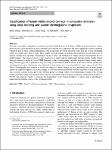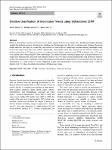Search
Author
- Osman, Ahmed I. (5)
- Daqing, Ma (3)
- Jorgensen, Ed (3)
- Li, Yan (3)
- next >
Subject
- kinh tế (26)
- Economics (12)
- programming (10)
- XRD (10)
- next >
Date issued
- 2020 - 2025 (2128)
- 2010 - 2019 (129)
- 2000 - 2009 (9)
- 1999 - 1999 (1)
Has File(s)
Search Results
Many current trackers utilise an appearance model to localise the target object in each frame. However, such approaches often fail when there are similar-looking distractor objects in the surrounding background, meaning that target appearance alone is insufficient for robust tracking. In contrast, humans consider the distractor objects as additional visual cues, in order to infer the position of the target. Inspired by this observation, this paper proposes a novel tracking architecture in which not only is the appearance of the tracked object, but also the appearance of the distractors detected in previous frames, taken into consideration using a form of probabilistic inference known as explaining away. |
Microbiome is closely related to many major human diseases, but it is generally analyzed by the traditional statistical methods such as principal component analysis, principal coordinate analysis, etc. These methods have shortcomings and do not consider the characteristics of the microbiome data itself (i.e., the “probability distribution” of microbiome). A new method based on probabilistic topic model was proposed to mine the information of gut microbiome in this paper, taking gut microbiome of type 2 diabetes patients and healthy subjects as an example. Firstly, different weights were assigned to different microbiome according to the degree of correlation between different microbiome and subjects. |
With the increasingly comprehensive utilisation of Carbon Fibre-Reinforced Polymers (CFRP) in modern industry, defects detection and characterisation of these materials have become very important and draw significant research attention. During the past 10 years, Artificial Intelligence (AI) technologies have been attractive in this area due to their outstanding ability in complex data analysis tasks. Most current AI-based studies on damage characterisation in this field focus on damage segmentation and depth measurement, which also faces the bottleneck of lacking adequate experimental data for model training. This paper proposes a new framework to understand the relationship between Barely Visible Impact Damage features occurring in typical CFRP laminates to their corresponding cont... |
Emotion classification can be a powerful tool to derive narratives from social media data. Traditional machine learning models that perform emotion classification on Indonesian Twitter data exist but rely on closed-source features. Recurrent neural networks can meet or exceed the performance of state-of-the-art traditional machine learning techniques using exclusively open-source data and models. Specifically, these results show that recurrent neural network variants can produce more than an 8% gain in accuracy in comparison with logistic regression and SVM techniques and a 15% gain over random forest when using FastText embeddings. |
Ranking aggregation, studied in the field of social choice theory, focuses on the combination of information with the aim of determining a winning ranking among some alternatives when the preferences of the voters are expressed by ordering the possible alternatives from most to least preferred. One of the most famous ranking aggregation methods can be traced back to 1959, when Kemeny introduces a measure of distance between a ranking and the opinion of the voters gathered in a profile of rankings. Using this, he proposed to elect as winning ranking of the election the one that minimizes the distance to the profile. This is factorial on the number of alternatives, posing a handicap in the runtime of the algorithms developed to find the winning ranking, which prevents its use in real ... |
In the last years, due to the availability and easy of use of image editing tools, a large amount of fake and altered images have been produced and spread through the media and the Web. A lot of different approaches have been proposed in order to assess the authenticity of an image and in some cases to localize the altered (forged) areas. In this paper, we conduct a survey of some of the most recent image forgery detection methods that are specifically designed upon Deep Learning (DL) techniques, focusing on commonly found copy-move and splicing attacks. DeepFake generated content is also addressed insofar as its application is aimed at images, achieving the same effect as splicing. This survey is especially timely because deep learning powered techniques appear to be the most relev... |
Optimization algorithms are used to improve model accuracy. The optimization process undergoes multiple cycles until convergence. A variety of optimization strategies have been developed to overcome the obstacles involved in the learning process. Some of these strategies have been considered in this study to learn more about their complexities. It is crucial to analyse and summarise optimization techniques methodically from a machine learning standpoint since this can provide direction for future work in both machine learning and optimization. The approaches under consideration include the Stochastic Gradient Descent (SGD), Stochastic Optimization Descent with Momentum, Rung Kutta, Adaptive Learning Rate, Root Mean Square Propagation, Adaptive Moment Estimation, Deep Ensembles, Feed... |
For the approximation and simulation of twofold iterated stochastic integrals and the corresponding Lévy areas w.r.t. a multi-dimensional Wiener process, we review four algorithms based on a Fourier series approach. Especially, the very efficient algorithm due to Wiktorsson and a newly proposed algorithm due to Mrongowius and Rößler are considered. To put recent advances into context, we analyse the four Fourier-based algorithms in a unified framework to highlight differences and similarities in their derivation. A comparison of theoretical properties is complemented by a numerical simulation that reveals the order of convergence for each algorithm. |
Longest common substring (LCS), longest palindrome substring (LPS), and Ulam distance (UL) are three fundamental string problems that can be classically solved in near linear time. In this work, we present sublinear time quantum algorithms for these problems along with quantum lower bounds. Our results shed light on a very surprising fact: Although the classic solutions for LCS and LPS are almost identical (via suffix trees), their quantum computational complexities are different. While we give an exact O~(n−−√) time algorithm for LPS, we prove that LCS needs at least time Ω~(n2/3) even for 0/1 strings. |
The fast improvement of deep learning methods resulted in breakthroughs in image classification, however, these models are sensitive to adversarial perturbations, which can cause serious problems. Adversarial attacks try to change the model output by adding noise to the input, in our research we propose a combined defense method against it. Two defense approaches have been evolved in the literature, one robustizes the attacked model for higher accuracy, and the other approach detects the adversarial examples. Only very few papers discuss both approaches, thus our aim was to combine them to obtain a more robust model and to examine the combination, in particular the filtering capability of the detector. Our contribution was that the filtering based on the decision of the detector is ... |









